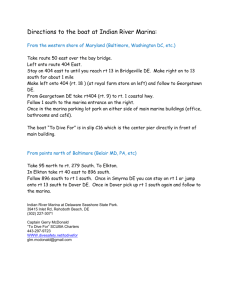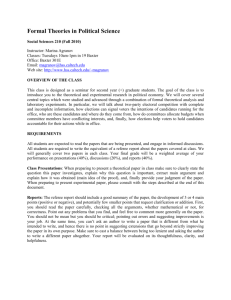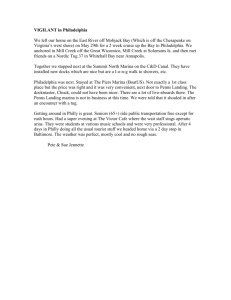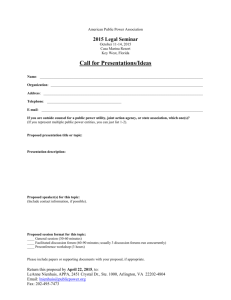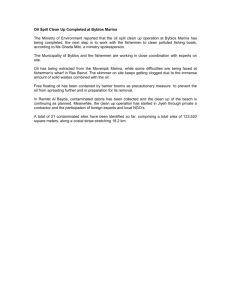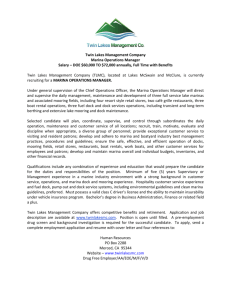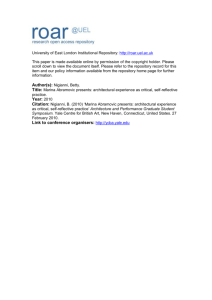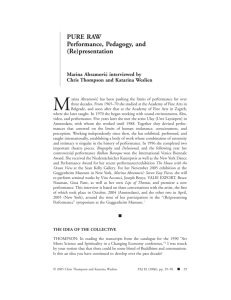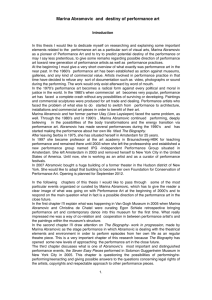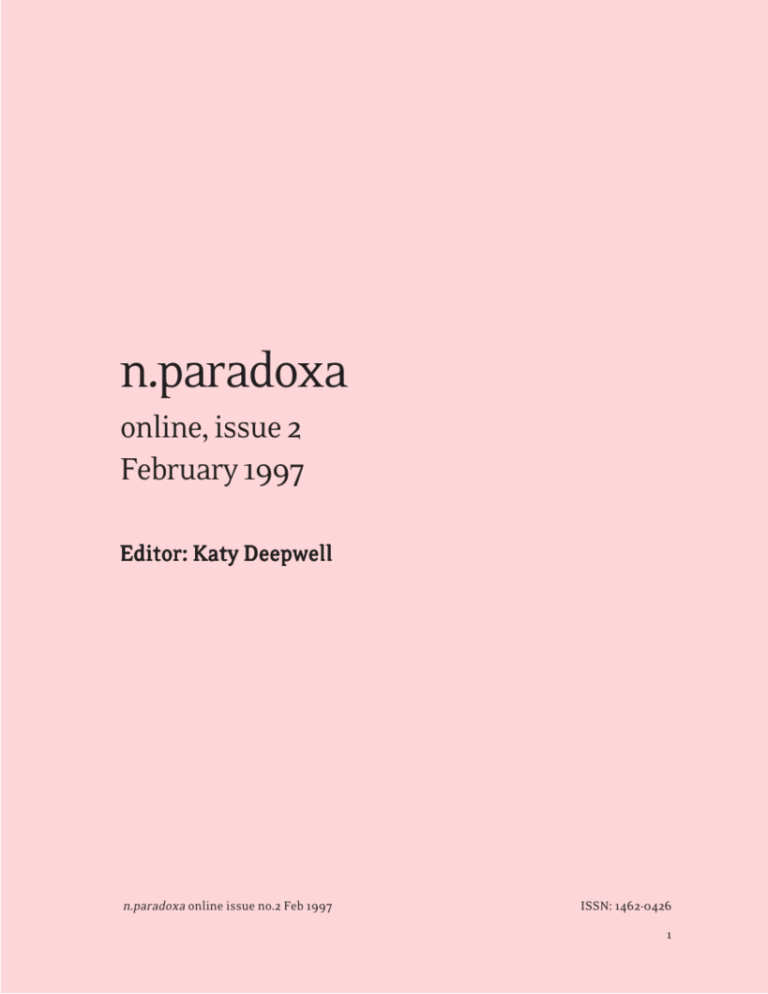
n.paradoxa
online, issue 2
February 1997
Editor: Katy Deepwell
n.paradoxa online issue no.2 Feb 1997
ISSN: 1462-0426
1
Published in English as an online edition
by KT press, www.ktpress.co.uk,
as issue 2, n.paradoxa: international feminist art journal
http://www.ktpress.co.uk/pdf/nparadoxaissue2.pdf
Dec 1997, republished in this form: January 2010
ISSN: 1462-0426
All articles are copyright to the author
All reproduction & distribution rights reserved to n.paradoxa and KT press.
No part of this publication may be reprinted or reproduced or utilized in any form or
by any electronic, mechanical or other means, including photocopying and recording,
information storage or retrieval, without permission in writing from the editor of
n.paradoxa.
Views expressed in the online journal are those of the contributors
and not necessarily those of the editor or publishers.
Editor: ktpress@ktpress.co.uk
International Editorial Board: Hilary Robinson, Renee Baert,
Janis Jefferies, Joanna Frueh, Hagiwara Hiroko, Olabisi Silva.
www.ktpress.co.uk
The following articles were republished in
Volume 1, n.paradoxa (print version) January 1998 :
Liz Ellis 'Do You Want to Be in My Gang?' An account of Ethics and Aesthetics in Contemporary Art
Practice an analysis of the Britpack phenomenon
Tomur Atagök A View of Contemporary Women Artists in Turkey
Hilary RobinsonNine Snapshots from living and working in Belfast
Katy Deepwell Questioning stereotypes of feminist art practice as ‘Feminist Aesthetics in an
International Frame’
Shelley Hornstein ‘Of Identities and Nationalism seen from Far and Near: Narelle Jubelin and the
Politics of Space’
n.paradoxa online issue no.2 Feb 1997
2
ISSN: 1462-0426
List of Contents
Liz Ellis 'Do You Want to Be in My Gang?'
An account of Ethics and Aesthetics in Contemporary Art
Practice, an analysis of the Britpack phenomenon
4
Tomur Atagök A View of Contemporary Women Artists in Turkey
20
Paradoxes and Orthodoxes : An Invitation to Dialogue from the Editor
26
N.Paradoxa: An Interview with Marina Abramovic
29
N.Paradoxa: Dialogue with Australian artist, Jill Scott
39
Feminist Art Criticism in an International Perspective: Three
Papers from the joint American and Canadian Association
of Aesthetics Conference from
Montreal , October 1996:
Hilary Robinson Nine Snapshots from living and working in Belfast
48
Katy Deepwell Questioning stereotypes of feminist art practice
55
Shelley Hornstein Of Identities and Nationalism seen from Far
and Near: Narelle Jubelin and the Politics of Space
63
n.paradoxa online issue no.2 Feb 1997
ISSN: 1462-0426
3
N.Paradoxa Interview with Marina Abramovic
Katy Deepwell
This conversation with Marina Abramovic t took place at her home in Amsterdam in
September 1996. In September 1996, Marina Abramovic’s The House, Five Rooms and Storage
, an installation for Visual Arts UK 96, was about to open at Middlesborough Art Gallery and
a major retrospective exhibition of her work was in preparation for the Groningen Museum,
Holland.
Katy Deepwell: I want to begin by asking you about your idea for the
installation The House, Five Rooms and Storage. Is it a model of a home? Or an
attempt to conceive of different metaphorical spaces?
Marina Abramovic: When I first came to Middlesborough and saw the space (a
former doctor’s surgery) , even though it was a gallery space, it had a homely feeling.
There were old carpets, a fireplace and lots of elements remaining from its former
use. It was not really a home or a gallery, it was something in between. So I was
interested in what it was before. Although they told me it was a living space before it
was a gallery, I like to work on locations and to take into consideration the history
of the building. I wanted to return the idea of the house to the space - so I traced
where was the living room, bathroom, kitchen etc. and where would be the storage
space. But I didn’t take it literally. I then made my own arrangement. This idea of
the house is more like a spirit house and the furniture is not normal furniture, its
my interpretation of that space. So, if you go to the bathroom, there is a copper bath
and a copper sink but the water has become like a mirror where you can go and look
at yourself or not. Copper transmits energy as a material . I like the idea of bathing
n.paradoxa online issue no.2 Feb 1997
ISSN: 1462-0426
29
in copper. In the old days, baths were made from copper but now its just a
purification or cleaning idea but the metaphor is still there. In the Bedroom, the
bed looks like a cross and the material is lead and rosequartz, which I had not
used before. I have made a bed for human use before, but here I made a bed for
spirit use - this is a bed for a dead spirit. When I first made a bed for spirit use the
idea was to make the invisible, visible. So by making a bed for a dead spirit you
could become aware of what a dead spirit might mean.
The storage place has a six metre high metal construction with two glass sides
of the cube. These are full of salt and coal. They are black and white, yes and no.
The TV room is very simple, a TV and one high chair. The audience is invited to sit
on the chair where their feet connot touch the floor facing the wall. The TV video
‘Image of Happiness’ is playing but the audience can only hear the video sound
and look at the blank wall. The space is a metaphor.
The house also refers to my earlier works and workshops with students as these
are called Cleaning the House. The question which house are you cleaning can
refer to the body as house. Even my own house in Amsterdam is arranged so that
each space has one activity at a time - a studio, thinking room, office, working
room, exercise room, a kitchen for eating. The whole house has a construction
that you can relate to the body. Louise Bourgeois,for example, made lots of
drawings of the body as a house.
Katy Deepwell: In your work, you tend to take something concrete and
simple but by adding a metaphor to it you succeed in shifting the meaning
quite dramatically. This creates quite powerful dissonances - but the work
affects the viewer in so far as it depends on bringing those different
associations together. Can you say something about your philosophy about
transitory objects.
Marina Abramovic: Using simple things? The only thing about being an artist
is that you must go inside of yourself because this is the thing you really know.
The deeper you go inside of yourself, the more you encounter another side of
yourself on which people can project. If you take all the personal stuff out of an
idea, it’s no longer just a private thing. You have to transform it to shift these
ideas to another perspective for things to become a kind of universal or
transcendent truth for anybody else. So like the last video work I made, The Onion,
I’m very proud of the title as it is so simple, in relation to women. Do you know how
many men come home and the woman is crying and they say I’m just cutting the
onions. This is one level, I used the onion as a tool to show something else, the
suffering. This is almost a religious piece...
n.paradoxa online issue no.2 Feb 1997
30
ISSN: 1462-0426
In the video, The Onion, Marina Abramovic, is filmed framed like a portrait
against a blue background. The image echoes representations of the Madonna,
particularly as the camera angle always looks up towards the face. Holding an onion
in her hand, she bites through and slowly devours the entire onion. As she eats the
pain becomes intense, her eyes water, but she continues eating nevertheless. The
soundtrack echoes this sense of resignation and endurance :
I am tired from changing planes so often. Waiting in the waiting rooms, bus
stations, train stations, airports.
I am tired of waiting for endless passport controls.
Fast shopping malls in shopping malls.
I am tired of more career decisions:museum and galllery openings, endless
receptions, standing around with a glass of plain water, pretending that I am
interested in conversation.
I am tired of my migrane attacks.
Lonely hotel room, room service, long distance telephone calls, bad TV movies.
I am tired of always falling in love with the wrong man.
I am tired of being ashamed of my nose being too big, of my ass being too large,
ashamed about the war in Yugoslavia.
I want to go away, somethere so far that I am unreachable by fax or telephone.
I want to get old, really old so that nothing matters any more.
I want to understand and see clearly what is behind all of this.
I want not to want anymore’
Text © Marina Abramovic,1996. Dallas, USA
Photos © Marina Abramovic Stills from video The Onion (1996)
Katy Deepwell: In The Onion, you’re also metaphorically peeling back the
Onion revealing different layers.
Marina Abramovic: There is an essence but no core. There is the hardness of
the skin and softness of the flesh. If you look in history, the most difficult thing is to
work in a simple way but if you succeed you can reach everybody. I’m not sure how
n.paradoxa online issue no.2 Feb 1997
ISSN: 1462-0426
31
many artists do this but I start with hundreds of ideas running around in my
baroque mind and then I start reducing, reducing. Can I say one thing with twenty
things, then with four, then 3 - finally can I say it with just one thing - a economic
art. I was in the symposium Art Meets Spirituality in an Economy where there was
much discussion of pollution but I think we should definitely be aware of art
pollution. There are today, thousands and thousands of artists producing all kinds
of art. The studios are stuffed with works - like a postoffice - producing, producing
but when you think how little work really matters, how little art makes real sense,
its incredible. All the really important artists of this century can really change the
way society thinks, Duchamp did it, Malevich did it, Rothko,Klein,Pollock - certain
key points and then the rest, you have thousands of people following their work.
Katy Deepwell: These are all artists who distil ideas, reduce to pure form.
Marina Abramovic: Yes, you need to reduce to the essence but it is a question
of how to get the essence out? But then you see how their work comes from a very
deep personal level and they succeed in shifting this experience into something
else.
Katy Deepwell: Your work is often discussed by others in rather waffly
terms of spirituality but I don’t see this method of work as a very spiritual
way of working. Maybe this is because of my own secular beliefs.
Marina Abramovic: I have a huge problem with the labels that are put on me
- New Age - spooky! It’s very interesting how the artworld today is competely allergic
to spirituality, religion or any of these things. It’s like spirituality is taken as a
negative concept rather than a positive one and this is so strange because for me
there is a spritual element in my work but not all of it. I don’t agree with the labels
which people project on to me.
Katy Deepwell: Maybe its necessary to use different terms to spirituality
and talk about what it means to be a human being, to live, experience - not
just in a spiritual dimension alone.
Marina Abramovic: Exactly, the spiritual is one dimenson and not the only one.
Katy Deepwell: A lot of descriptions I read refer to your work as emotional,
intuitive. It doesn’t seem to me that this is what you are doing and is more
the result of prejudices of Western critics about the feminine.Even though
you are using your body as a medium, there’s a great deal of intellectual
thought behind it.
n.paradoxa online issue no.2 Feb 1997
32
ISSN: 1462-0426
Marina Abramovic: This generally comes after you’ve done something . When
the idea comes, whether you’re in the kitchen - or on the way to the airport, most of
the time I have a fear of the idea as it’s usually something outrageous. But then I
know I have to do it. In my catalogues, there are many works I have done where in
the beginning I have no idea why I have done them or of their relationship to other
works. They came as an urge - from mind and body and only later could I rationalise
why I did something and discover their relationship to other pieces. I get the idea
and this always comes as a surprise - it comes from the stomach. Intuition is
important , I do a lot of work on my body to be prepared to receive such an idea.
That’s why the body is a house. And why I do a lot of exercise, eat pure food and
eliminate obstructions. To keep the house clean. The body is a receiver.
Katy Deepwell: This is like the medium, the spirit inhabing the body.
Marina Abramovic: I believe the artist should be an antenna - a vibrating
antennae.
Katy Deepwell: In one of the articles I read you described yourself as the
‘Grandmother of Performance Art’ - along with Ulrike Rosenbach and Gine Pane unlike the younger generation of video and installation artists or the ‘Bad Girls’,
you always use real time, instead of using loops or technology to simulate
experience. Their work, by contrast, seems less concerned with physical experience
within the performance and more concerned with the ephemera of culture, language
games , media games/codes.
Marina Abramovic: It is very interesting when I first met, Pipilotti Rist (a Swiss
video artist) I loved the construction of her installations but they are often too much
like MTV. She’s a very nice girl but when she was introduced to me she was completely
shocked ‘Oh, you’re really alive!’. It was as if there was such a difference in age and
somehow I’m part of history and don’t exist as a person. so I said ‘Yes, I’m really
alive!’ The younger generation do seem ignorant or they don’t want to know the work
of the seventies because they repeat the same ideas and many young critics don't
refer to the earlier work for comparison, which is unfair. Either they just copy or
what is equally possible, they just get very similar ideas. Like sleeping in the gallery
(which Georgina Starr invited an actress to do at the Serpentine Gallery in 1995),
Chris Burden and Ulay and I did this but it was so funny to see the huge publicity in
the British Press, but you have another ten artists after Chris Burden who did the
same thing and here it is presented as the latest thing.
From my own experience, I know of lots of artists who really redo my work all
over the world sometimes referencing me – sometimes not. There was a piece we
were invited to in a museum in New Zealand – which borrowed from an earlier
n.paradoxa online issue no.2 Feb 1997
ISSN: 1462-0426
33
piece by Ulay and I called Inpoderabilia (Bologna, 1977) – where two people stood
in a doorway and the audience had to walk past but the only difference was the
girl and boy were dressed not nude.
Then I got an invitation from 5 young artists in Poland to come and see a
performance called Marina Positions. At first I was really angry but when I
was watching the piece I thought it was fantastic and I understood that the
idea of originality as my-ego-my art is completely an obstacle to the essence of
performance. A performance should be like a musical score - like Mozart,
subject to interperetation and it can be performend as you want. I want to
promote this idea at the ICA’s 50th Anniversary next year and to do a
performance based on the performances of the seventies - a historical view of
6 pieces – 5 by other artists I like and the last my own. I am interesting in
reperforming Chris Burden’s work on Crucifixion with gold nails. I really want
to do this with the permission of the artists because I want to honour their
work and how it was with my interpretation. I hope that this will open up the
idea of performance as a free concept and demystify the 70s. Instead of the
photo and all this projection on events where you were not there. I want to
perform in this series, three I did not see - one from each continent. I actually
want to do these performances. I think it would be interesting to have a woman
on the cross in Burden’s crucifixion.
Katy Deepwell: But it would change the meaning.
Marina Abramovic: Yes and so would Seedbed by Acconci where he raised the
floor of the gallery and masturbated under the floor. The artist’s seed was supposedly
inspiration.
When I was in the Art Academy, on the first day, when there were 2 women
students among 17 men , an old professor came to us and said ‘to be an artist , you
have to have balls’ I was shocked by this because all I wanted to be was a good artist
with or without balls.
In another recent video work Image of Happiness which was shown as part of
the installation at Middlesborough, the camera frame is focused on Abramovic’s
face. This time she is hanging upside down. A fact which only becomes apparent as
you watch the entire video and see the blood rushing to her face and her struggle to
speak the narrative. She repeats three times, the same words, a poetic description of
the moment when a wife welcomes her husband home. The image is sealed by the
touch of the husband’s hand on the woman’s pregnant belly.
Katy Deepwell: Would you say there was irony in Image of Happiness
between the action and the words you are speaking?
n.paradoxa online issue no.2 Feb 1997
34
ISSN: 1462-0426
Marina Abramovic: No,absolutely not. In the early 1970s I wanted to be very
radical, extremely focused both mentally and physically. Everything else was just
groovy. Ulay and I made all these works together. When we came to walking the
Chinese wall, I made a big separation with the major love of my life and, for a time,
everything was falling apart. When I finished the Wall, the pain was so big it took
me about 2-3 years to get over it. It is only through my work that I can express my
emotions At that time I was 40, ending a very strong emotional relationship, and I
was intending to make my own work. I was at rock bottom zero , leaving everything
behind. It was the hardest part of my life.
Then I realised one thing that everybody has many personalities inside
themselves and it is all the time will-power which decides which one one presents
to the world. My presentation of myself was just one aspect of me - a heavy one
going out into the world. This came out in A Biography. I had reached a stage in
my life where I could restage performances, pasting, cutting, knives and acting
which I cannot do (I was making fun of myself). When people saw my works, they
were scared to talk to me in reality but my friends who didn’t know the work could
not believe that I made this work because there was a contradiction in their eyes.
Then I found out that there are contradictions worth exploring . I love kitsch, I
indulge myself with sweets, vanity, fashion. I love to make fun of myself, a very
black humour, often politically incorrect. These are all these aspects which my
friends know in a private situation about me and then there other aspects of
myself which I explore through the works. In ‘Image of Happiness’ the image is
something I really wish in one part of myself but it is not all of myself. It would
be a dream to have a husband , family etc. but the other side of my self is stronger
and I threw it away.
At 50, I now realise I can say this is how it is. One of the most difficult things is to
do things you are ashamed of. My second theatre piece was called Delusional, to
show people about shame as one of the most difficult emotions.
Katy Deepwell: Perhaps this is another difference from younger women
whose works are more playful, ridiculous but more obviously mediated by the
popular media whereas your pieces seem to be more about real life and
experiences which are full of contradictions.
Marina Abramovic: I can only talk about spaces or experiences if I have been
there. Otherwise I cannot presume things. I need to be honest, to have gone through
this experience and then do something from this.
Katy Deepwell: How would you define the feminine in relation to the feminist
- one of the definitions from the 1970s was the idea of making the personal,
political - that one should take personal experience and make it into political
n.paradoxa online issue no.2 Feb 1997
ISSN: 1462-0426
35
statements. This seems to be what you are exploring but I don't know whether
you would call it feminist?
Marina Abramovic: Do you see me as a feminist?
Katy Deepwell: Not in your presentation of your work but in the idea of
exploring the self or questioning the self in the way that you do in this work, I
would see you as identifying with the feminist project
Marina Abramovic: I really don't think so. I explore the self as any man does,
OK but I do so as a woman. I didn’t know what feminism was until I was 30 years old.
I came from Yugoslavia where women are very strong. My mother was a Maitre in
the Army. She was Director of Museum of Art and Revolution. All her friends were in
high positions with the Ministry of Culture. women were totally equal in Yugoslavian
society after the revolution. I came from this kind of background and I always thought
the women were much stronger and more powerful than many men. When I left
Yugoslavia, I saw this confrontation of women in the press. For me , its a completely
psychological thing, if you believe in your own power, you can do anything you want.
I never had in my life to do anything I didn’t want to.
When I came to Italy, I had many shows and lots of work and I looked around and
saw there was not one Italian woman artist in the same position , except Marisa
Merz who was always hidden behind Mario Merz. And many women said ‘Oh, we
can’t do anything’. We can do anything we want! I was very much against this idea of
a ghetto. Many of the exhibitions of women’s work I have seen , have been of very
poor quality, because its a lot of bad art with 2 or 3 good artists invited in. I have
never seen a really good exhibition of feminist art. If you put yourself in a ghetto,
you deny the real meaning of art - art has to be good art whether by a man or a woman.
Katy Deepwell: Feminism is frequently only identified with as a language
of oppression - or a ‘ghetto’ politics. This understanding of feminism as
synonymous with oppression has become restrictive and many people regard
it as no longer viable. I think it is necessary to go beyond this set of ideas
which is not necessarily either an art world label, not is it caught only in
questions about oppression and discrimination (which hasn’t gone away). For
example, ideas about how you express your subjectivity through embodiment
are close to some French feminist writing like Irigaray or Wittig which are
often problematically attached to the label feminist, more to the feminine. Are
you familiar with these ideas?
Marina Abramovic: Women artists always try not to attach themselves to
notions of the feminine - by wearing certain types of clothes or not wearing maken.paradoxa online issue no.2 Feb 1997
36
ISSN: 1462-0426
up. There was a critic in a newspaper in Germany who wrote ‘Rebecca Horn has good
connections and Marina Abramovic is too beautiful to be an artist’ I don’t think so.
Feminism seems always to be about obstacles.
Katy Deepwell: Lucy Lippard made the same argument about European
women artists in her essay on ‘The Pains and Pleasures of Women’s Body Art’
(From the Center) arguing that many women use their physical appearence skin - beautiful bodies - in order to make their work accepted or acceptable to
male curators. This, she states, is not the case in America.
I am interested in exploring the popular currency of certain American ideas
and the differences in Europe. Everyone here is aware of discrimination and
oppression against women but the point is to go on producing and speak about
other kinds of experience. It is however necessary to overcome the almostautomatic dismissal of feminism. Maybe it’s also particular to different
situations and where you come from in terms of background.
Marina Abramovic: Background is very important. If you come from Germany
where it definitely is a rule that the major artists are all male and its very difficult to
get a job if you are female. Whereas in Yugoslavia , you’re a hero!
Katy Deepwell: As you get older, are you still interested in making works
which push your physical body to the limit?
Marina Abramovic: Oh yes, more than ever. Being 50 in American culture is
something to hide, in my culture, this is dignity, something you really get to know
on another level of consciousness - another part of my life. As an artist you really
have to know when to stop and when to die , because so many artists repeat
themselves. In a lifetime you don’t have 30,000 good ideas. In one artist’s lifetime,
he or she may have one good idea.
Katy Deepwell: There are lots of artists who go on working until they’re 90
- look at Louise Bourgeois or Louise Nevelson.
Marina Abramovic: No, no, I want to go on to 100. This is not the problem. You
have to concentrate differently. It is not important whether to stop here or here.
There are real projects which can help you go further and it’s a question of stopping,
focusing, recentering on what you should be doing.
But at 50, the administration for an artist is frightening, letters,faxes, send things
here, there and you are overbooked.
I want to make a performance work which is about the limits of the Eastern body
and the limits of the Western body.
n.paradoxa online issue no.2 Feb 1997
ISSN: 1462-0426
37
Katy Deepwell: How would you define these distinctions?
Marina Abramovic: Well , it’s using the knowledge of people from the East, taking
the body beyond our physical limits (through fasting, meditation, levitation). The
West doesn’t live though the body it lives through the brain.
Selected Bibliography,1992-1996
Beatrix Ruf (foreword) Marina Abramovic: Double Edge (Kunstmuseum des Kantons,
Thurgau, Kartause Ittingen, October 1995-April 1996)
Johan Pijnappel & Geert Schiever Marina Abramovic: Cleaning the House (London:
Academy,1995)
Marina Abramovic Marina Abramovic: Objects,Performance,Video,Sound (Oxford:
Museum of Modern Art,1995)
Bojana Pejic Marina Abramovic (Berlin: Cantz,1993)
Marina Abramovic The Spatial Drive (New York: New Museum of Contemporary Art,1992)
‘Marina Abramovic ’ Interview with Ingrid Hoogervorst’ Ruimte 2 1992 Jaargang 9
Copyright © : Katy Deepwell, 1997
n.paradoxa : Issue 2, February 1997
This interview was republished in Italian in Emanuela de Cecco and Gianni Romano (eds)
Contemporanee: Percorsi, lavori e poetiche delle artiste dagli anni Ottanta a oggi (Milan: Costa and
Nolan: Editori Associati, srl, 2000) pp.88-98
n.paradoxa online issue no.2 Feb 1997
38
ISSN: 1462-0426

